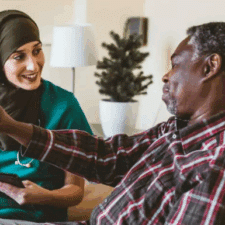
Multiple myeloma, a type of blood cancer, significantly impacts your bone health. If you are living with this condition, you may experience bone pain as a prevalent and debilitating symptom. This pain results from cancerous plasma cells accumulating in your bone marrow, leading to various bone-related complications. According to research, 80 percent of people who are newly diagnosed with multiple myeloma develop holes, weak spots, and other types of damage in bones.
In this article, we’ll explore how multiple myeloma affects your bones, the mechanisms behind bone damage, and practical strategies for maintaining bone health.
How Multiple Myeloma Damages Your Bones
Disruption of Bone Remodeling
Your bones are not static structures. They are living, dynamic tissues that constantly remodel themselves to stay strong and healthy. This ongoing cycle involves two main types of cells:
You May Also Like
- Osteoclasts, which break down old or damaged bone tissue
- Osteoblasts, which form new bone to replace what’s been lost
In healthy individuals, these two processes remain in balance. However, multiple myeloma disrupts this balance at a fundamental level.
Dr. Elan Gorshein, a hematologist at Yale School of Medicine, tells Everyday Health that multiple myeloma causes osteoclasts to continuously break down your bone without the usual checks and balances. Simultaneously, it inhibits osteoblasts from repairing and forming new bone. This imbalance leads to weakened bones, resulting in holes, weak spots, and other types of damage known as lytic lesions. Dr. Azra Borogovac, a hematologist at the City of Hope Orange County Lennar Foundation Cancer Center, explains that these lesions can lead to osteoporosis and other severe bone complications.
Prevalence and Locations of Bone Lesions
Bone lesions are among the most common complications of multiple myeloma. Research suggests that about 90 percent of individuals with the disease will develop lytic bone lesions at some point during their illness.
You May Also Like
These lesions often appear in areas of the body that bear the most weight or contain large amounts of bone marrow, such as:
- The spine, where lesions can cause vertebral collapse and nerve compression
- The rib cage, leading to chest pain and difficulty breathing
- The pelvis and hips, which can compromise walking and balance
- The skull, where lesions may cause tenderness or visible deformities
Because the spine is so commonly affected, patients may experience chronic back pain, loss of height, or even sudden paralysis if a vertebra collapses onto the spinal cord. In some cases, emergency medical intervention is required to stabilize the bones or relieve nerve pressure.
RELATED: What Is Your Best Multiple Myeloma Treatment Option?

Strategies to Maintain Your Bone Health
Despite the challenges posed by multiple myeloma, there are several effective strategies to protect and strengthen your bones, manage pain, and improve your quality of life.
Medication
Staying on top of your medication is crucial. Dr. Gorshein emphasizes the importance of adhering to prescribed treatments, including myeloma-directed therapies and bone-modifying agents. These treatments not only target the cancer but also help mitigate bone damage by reducing the number of myeloma cells that disrupt the bone remodeling process.
Nutrition
A healthy diet plays a vital role in your bone health. Studies suggest that a diet rich in fruits can reduce the risk of monoclonal gammopathy of undetermined significance (MGUS), a precursor to multiple myeloma. Eating fruits at least three times a week has shown the greatest benefit. Additionally, maintaining adequate levels of vitamin D is essential, as deficiencies are common in multiple myeloma patients. However, it’s important to consult your doctor before starting any supplementation.
Exercise
Engaging in regular physical activity is beneficial for everyone, including those with multiple myeloma. Weight-bearing exercises, such as walking, jogging, and weightlifting, are particularly effective in boosting your bone health. Aerobic and strength training can help reduce fatigue and prevent muscle weakness. Dr. Gorshein also recommends activities like biking, swimming, and yoga to maintain balance and flexibility, which can prevent falls and fractures.

Surgical Interventions
In cases where fractures or spinal compression occur, surgical procedures can help stabilize your bones and relieve pressure on the spinal cord. These interventions are crucial in managing severe bone complications and maintaining mobility.
Lifestyle Changes
Quitting smoking is another critical step in protecting your bone health. Smoking cessation has been shown to improve bone density and reduce the risk of fractures. Therefore, if you smoke, it’s essential to seek support to quit as soon as possible.
Multiple myeloma significantly affects your bone health, causing pain and increasing the risk of fractures. However, with appropriate medication, a healthy diet, regular exercise, potential surgical interventions, and lifestyle changes like quitting smoking, you can manage symptoms and maintain a better quality of life. By understanding the impact of multiple myeloma on your bones and implementing these strategies, you can take proactive steps to protect your bone health and overall well-being.
Living Well With Multiple Myeloma
Multiple myeloma profoundly affects bone health, but it doesn’t have to define your quality of life. By working closely with your healthcare team and taking proactive steps—through medication, nutrition, exercise, and lifestyle changes—you can preserve bone strength, manage pain, and maintain independence.
Awareness and early intervention make a difference. If you experience new or worsening bone pain, fractures, or mobility changes, notify your doctor immediately. Early action can prevent complications and help you stay active and strong.
With the right care plan and a focus on bone health, living well with multiple myeloma is not only possible—it’s achievable.








